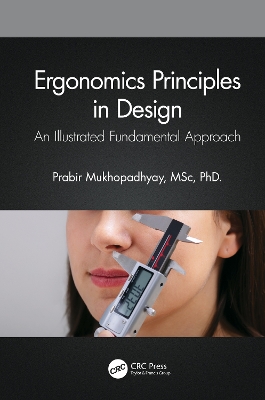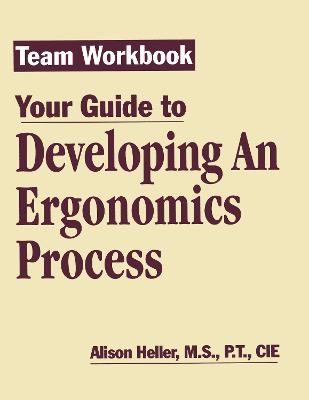Ergonomics Principles in Design
 portes grátis
portes grátis
Ergonomics Principles in Design
An Illustrated Fundamental Approach
Mukhopadhyay, Prabir
Taylor & Francis Ltd
10/2024
146
Mole
9781032299600
Pré-lançamento - envio 15 a 20 dias após a sua edição
Descrição não disponível.
Chapters
1. Introduction
Overview
1.1. Application of ergonomics in design
1.2. Ergonomics in tangible and intangible design
1.3. Where exactly in the design process ergonomics could be applied
1.4. Areas of ergonomic application in product, space and communication design
1.5. Thrust areas one must keep in mind while applying ergonomic principles in design
1.6. Documentation
1.7. Key Points
1.8. Practice session
2. Breaking the ice exercises
Overview
2.1. Identify ergonomics and design around
2.2. Note down the good and bad ergonomics in design around you
2.3. The way forward through ergonomic application in design
2.4. Template for assignments for data collection, synthesis, and analysis
2.4.1 Documentation and portfolio
2.4.2 Key Points
2.5 Practice session
3.Product Ergonomics
Overview
3.1 Ergonomics in simple product design
3.1.1Hammer
3.1.2Door handle
3.1.3Trolley bag handle
3.1.4Water bottle
3.1.5 Garden pruner
3.2 Bigger product
3.2.1 Refrigerator
3.2.2 Automated Teller Machine
3.2.3 Ladder
3.2.4 Water Faucet
3.2.5 Key Points
3.3 Practice session
4.Ergonomics in workspace
Overview
4.1 Groundwork
4.2 Shoe store
4.2.1 Layout
4.2.2 Flow of people in space
4.2.3 Fitting workstation
4.2.4 Seat height
4.2.5 Display racks
4.2.6 Storage area
4.2.7 Cash counter
4.3 Ergonomic issues
4.4 Ergonomic directions
4.5 Key Points
4.6Practice session
5.Ergonomics in moving space (Transportation)
Overview
5.1 Introduction
5.2 Some directions for ergonomics in moving space related projects
5.3 Ergonomic design intervention in the general compartment of railways
5.3.1 Movement of commuters
5.3.2 Task flow analysis
5.3.3 Ergonomic issues identified through direct observation
5.3.4 Emergency chain
5.3.5 Ladder for climbing the upper berths/seats
5.3.6 Layout of the compartment to enhance ease of movement and passenger comfort
5.3.6.1 Concept 1
5.3.6.2 Concept 2
5.3.6.3 Relaxed Seating
5.3.6.4 Final Concept
5.3. 6.5 Concept refinement
5.3.6.6 Rig Testing
5.4 Key Points
5.5 Practice session
6.Ergonomics in communication
Overview
6.1 Introduction
6.2 Some directions for ergonomics in communication design
6.3 Fire extinguisher
6.4 Pesticide packaging
6.5 Wayfinding map for a college campus
6.6 Ergonomics at homework station
6.7 Key Points
6.8 Practice session
7.Ergonomics in User Interface Design
Overview
7.1 Introduction
7.2 Some directions for applying ergonomic principles
7.3 Example 1: Ergonomic design of the interface of a blood pressure monitor
7.4 Example 2: Ergonomic design of a movie ticket vending machine interface
7.5 Example 3: Ergonomic design of the interface of a coffee vending machine on a college campus
7.6 Key Points
7.7 Practice session
8.Report and portfolio
8.1 Overview
8.2 Key Points
9.Application of mannequin in ergonomics
9.1 Introduction
9.2 Mannequins of different percentile values
9.3 Scale down grid boards which can be used for checking the designs either on paper or in the laboratory on the grid board to scale.
9.4 Usage of mannequin and grid boards for testing out the ergonomic design
9.5 Key Points
References
1. Introduction
Overview
1.1. Application of ergonomics in design
1.2. Ergonomics in tangible and intangible design
1.3. Where exactly in the design process ergonomics could be applied
1.4. Areas of ergonomic application in product, space and communication design
1.5. Thrust areas one must keep in mind while applying ergonomic principles in design
1.6. Documentation
1.7. Key Points
1.8. Practice session
2. Breaking the ice exercises
Overview
2.1. Identify ergonomics and design around
2.2. Note down the good and bad ergonomics in design around you
2.3. The way forward through ergonomic application in design
2.4. Template for assignments for data collection, synthesis, and analysis
2.4.1 Documentation and portfolio
2.4.2 Key Points
2.5 Practice session
3.Product Ergonomics
Overview
3.1 Ergonomics in simple product design
3.1.1Hammer
3.1.2Door handle
3.1.3Trolley bag handle
3.1.4Water bottle
3.1.5 Garden pruner
3.2 Bigger product
3.2.1 Refrigerator
3.2.2 Automated Teller Machine
3.2.3 Ladder
3.2.4 Water Faucet
3.2.5 Key Points
3.3 Practice session
4.Ergonomics in workspace
Overview
4.1 Groundwork
4.2 Shoe store
4.2.1 Layout
4.2.2 Flow of people in space
4.2.3 Fitting workstation
4.2.4 Seat height
4.2.5 Display racks
4.2.6 Storage area
4.2.7 Cash counter
4.3 Ergonomic issues
4.4 Ergonomic directions
4.5 Key Points
4.6Practice session
5.Ergonomics in moving space (Transportation)
Overview
5.1 Introduction
5.2 Some directions for ergonomics in moving space related projects
5.3 Ergonomic design intervention in the general compartment of railways
5.3.1 Movement of commuters
5.3.2 Task flow analysis
5.3.3 Ergonomic issues identified through direct observation
5.3.4 Emergency chain
5.3.5 Ladder for climbing the upper berths/seats
5.3.6 Layout of the compartment to enhance ease of movement and passenger comfort
5.3.6.1 Concept 1
5.3.6.2 Concept 2
5.3.6.3 Relaxed Seating
5.3.6.4 Final Concept
5.3. 6.5 Concept refinement
5.3.6.6 Rig Testing
5.4 Key Points
5.5 Practice session
6.Ergonomics in communication
Overview
6.1 Introduction
6.2 Some directions for ergonomics in communication design
6.3 Fire extinguisher
6.4 Pesticide packaging
6.5 Wayfinding map for a college campus
6.6 Ergonomics at homework station
6.7 Key Points
6.8 Practice session
7.Ergonomics in User Interface Design
Overview
7.1 Introduction
7.2 Some directions for applying ergonomic principles
7.3 Example 1: Ergonomic design of the interface of a blood pressure monitor
7.4 Example 2: Ergonomic design of a movie ticket vending machine interface
7.5 Example 3: Ergonomic design of the interface of a coffee vending machine on a college campus
7.6 Key Points
7.7 Practice session
8.Report and portfolio
8.1 Overview
8.2 Key Points
9.Application of mannequin in ergonomics
9.1 Introduction
9.2 Mannequins of different percentile values
9.3 Scale down grid boards which can be used for checking the designs either on paper or in the laboratory on the grid board to scale.
9.4 Usage of mannequin and grid boards for testing out the ergonomic design
9.5 Key Points
References
Este título pertence ao(s) assunto(s) indicados(s). Para ver outros títulos clique no assunto desejado.
Ergonomic Principles;Documentation;Product Ergonomics;Task Flow Analysis;Communication Design;Product Design;Anthropometric Dimensions;Ergonomic Issues;Grid Board;Maximum Body Depth;Ergonomic Design;Maximum Body Breadth;Elbow Height;Percentile Values;Handheld Product;Ergonomic Analysis;Ladder Rungs;Handheld;Digital Blood Pressure Monitor;Coffee Vending Machine;Hand Handle Interface;Compartment Layout;Luggage Rack;Popliteal Height;Visual Ergonomic;Display Racks;Buttock Knee Length;Seat Height;Trolley Bag;Palm Breadth
Chapters
1. Introduction
Overview
1.1. Application of ergonomics in design
1.2. Ergonomics in tangible and intangible design
1.3. Where exactly in the design process ergonomics could be applied
1.4. Areas of ergonomic application in product, space and communication design
1.5. Thrust areas one must keep in mind while applying ergonomic principles in design
1.6. Documentation
1.7. Key Points
1.8. Practice session
2. Breaking the ice exercises
Overview
2.1. Identify ergonomics and design around
2.2. Note down the good and bad ergonomics in design around you
2.3. The way forward through ergonomic application in design
2.4. Template for assignments for data collection, synthesis, and analysis
2.4.1 Documentation and portfolio
2.4.2 Key Points
2.5 Practice session
3.Product Ergonomics
Overview
3.1 Ergonomics in simple product design
3.1.1Hammer
3.1.2Door handle
3.1.3Trolley bag handle
3.1.4Water bottle
3.1.5 Garden pruner
3.2 Bigger product
3.2.1 Refrigerator
3.2.2 Automated Teller Machine
3.2.3 Ladder
3.2.4 Water Faucet
3.2.5 Key Points
3.3 Practice session
4.Ergonomics in workspace
Overview
4.1 Groundwork
4.2 Shoe store
4.2.1 Layout
4.2.2 Flow of people in space
4.2.3 Fitting workstation
4.2.4 Seat height
4.2.5 Display racks
4.2.6 Storage area
4.2.7 Cash counter
4.3 Ergonomic issues
4.4 Ergonomic directions
4.5 Key Points
4.6Practice session
5.Ergonomics in moving space (Transportation)
Overview
5.1 Introduction
5.2 Some directions for ergonomics in moving space related projects
5.3 Ergonomic design intervention in the general compartment of railways
5.3.1 Movement of commuters
5.3.2 Task flow analysis
5.3.3 Ergonomic issues identified through direct observation
5.3.4 Emergency chain
5.3.5 Ladder for climbing the upper berths/seats
5.3.6 Layout of the compartment to enhance ease of movement and passenger comfort
5.3.6.1 Concept 1
5.3.6.2 Concept 2
5.3.6.3 Relaxed Seating
5.3.6.4 Final Concept
5.3. 6.5 Concept refinement
5.3.6.6 Rig Testing
5.4 Key Points
5.5 Practice session
6.Ergonomics in communication
Overview
6.1 Introduction
6.2 Some directions for ergonomics in communication design
6.3 Fire extinguisher
6.4 Pesticide packaging
6.5 Wayfinding map for a college campus
6.6 Ergonomics at homework station
6.7 Key Points
6.8 Practice session
7.Ergonomics in User Interface Design
Overview
7.1 Introduction
7.2 Some directions for applying ergonomic principles
7.3 Example 1: Ergonomic design of the interface of a blood pressure monitor
7.4 Example 2: Ergonomic design of a movie ticket vending machine interface
7.5 Example 3: Ergonomic design of the interface of a coffee vending machine on a college campus
7.6 Key Points
7.7 Practice session
8.Report and portfolio
8.1 Overview
8.2 Key Points
9.Application of mannequin in ergonomics
9.1 Introduction
9.2 Mannequins of different percentile values
9.3 Scale down grid boards which can be used for checking the designs either on paper or in the laboratory on the grid board to scale.
9.4 Usage of mannequin and grid boards for testing out the ergonomic design
9.5 Key Points
References
1. Introduction
Overview
1.1. Application of ergonomics in design
1.2. Ergonomics in tangible and intangible design
1.3. Where exactly in the design process ergonomics could be applied
1.4. Areas of ergonomic application in product, space and communication design
1.5. Thrust areas one must keep in mind while applying ergonomic principles in design
1.6. Documentation
1.7. Key Points
1.8. Practice session
2. Breaking the ice exercises
Overview
2.1. Identify ergonomics and design around
2.2. Note down the good and bad ergonomics in design around you
2.3. The way forward through ergonomic application in design
2.4. Template for assignments for data collection, synthesis, and analysis
2.4.1 Documentation and portfolio
2.4.2 Key Points
2.5 Practice session
3.Product Ergonomics
Overview
3.1 Ergonomics in simple product design
3.1.1Hammer
3.1.2Door handle
3.1.3Trolley bag handle
3.1.4Water bottle
3.1.5 Garden pruner
3.2 Bigger product
3.2.1 Refrigerator
3.2.2 Automated Teller Machine
3.2.3 Ladder
3.2.4 Water Faucet
3.2.5 Key Points
3.3 Practice session
4.Ergonomics in workspace
Overview
4.1 Groundwork
4.2 Shoe store
4.2.1 Layout
4.2.2 Flow of people in space
4.2.3 Fitting workstation
4.2.4 Seat height
4.2.5 Display racks
4.2.6 Storage area
4.2.7 Cash counter
4.3 Ergonomic issues
4.4 Ergonomic directions
4.5 Key Points
4.6Practice session
5.Ergonomics in moving space (Transportation)
Overview
5.1 Introduction
5.2 Some directions for ergonomics in moving space related projects
5.3 Ergonomic design intervention in the general compartment of railways
5.3.1 Movement of commuters
5.3.2 Task flow analysis
5.3.3 Ergonomic issues identified through direct observation
5.3.4 Emergency chain
5.3.5 Ladder for climbing the upper berths/seats
5.3.6 Layout of the compartment to enhance ease of movement and passenger comfort
5.3.6.1 Concept 1
5.3.6.2 Concept 2
5.3.6.3 Relaxed Seating
5.3.6.4 Final Concept
5.3. 6.5 Concept refinement
5.3.6.6 Rig Testing
5.4 Key Points
5.5 Practice session
6.Ergonomics in communication
Overview
6.1 Introduction
6.2 Some directions for ergonomics in communication design
6.3 Fire extinguisher
6.4 Pesticide packaging
6.5 Wayfinding map for a college campus
6.6 Ergonomics at homework station
6.7 Key Points
6.8 Practice session
7.Ergonomics in User Interface Design
Overview
7.1 Introduction
7.2 Some directions for applying ergonomic principles
7.3 Example 1: Ergonomic design of the interface of a blood pressure monitor
7.4 Example 2: Ergonomic design of a movie ticket vending machine interface
7.5 Example 3: Ergonomic design of the interface of a coffee vending machine on a college campus
7.6 Key Points
7.7 Practice session
8.Report and portfolio
8.1 Overview
8.2 Key Points
9.Application of mannequin in ergonomics
9.1 Introduction
9.2 Mannequins of different percentile values
9.3 Scale down grid boards which can be used for checking the designs either on paper or in the laboratory on the grid board to scale.
9.4 Usage of mannequin and grid boards for testing out the ergonomic design
9.5 Key Points
References
Este título pertence ao(s) assunto(s) indicados(s). Para ver outros títulos clique no assunto desejado.
Ergonomic Principles;Documentation;Product Ergonomics;Task Flow Analysis;Communication Design;Product Design;Anthropometric Dimensions;Ergonomic Issues;Grid Board;Maximum Body Depth;Ergonomic Design;Maximum Body Breadth;Elbow Height;Percentile Values;Handheld Product;Ergonomic Analysis;Ladder Rungs;Handheld;Digital Blood Pressure Monitor;Coffee Vending Machine;Hand Handle Interface;Compartment Layout;Luggage Rack;Popliteal Height;Visual Ergonomic;Display Racks;Buttock Knee Length;Seat Height;Trolley Bag;Palm Breadth







